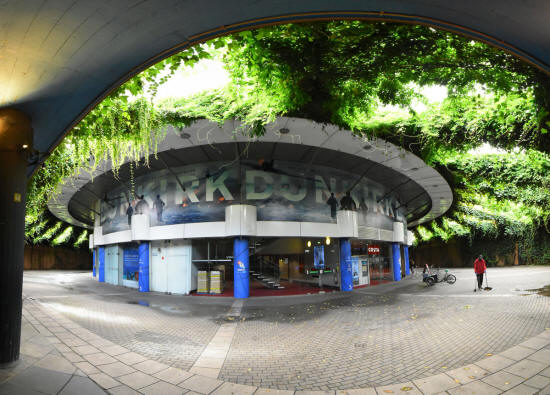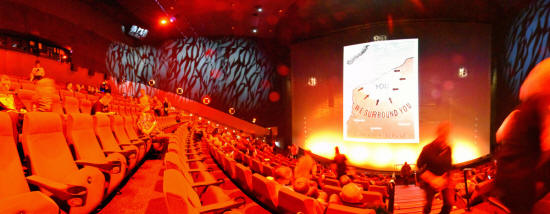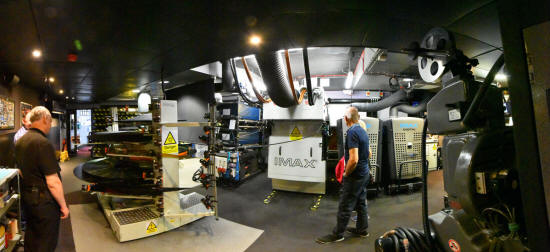A Brief History of Wartime |
Read more at in70mm.com The 70mm Newsletter |
| Written by: Mark Lyndon. Photographed by: Thomas Hauerslev | Date: 01.08.2017 |
 The
BFI IMAX entrance near Waterloo station on the South Bank in London. Click
to see enlargement The
BFI IMAX entrance near Waterloo station on the South Bank in London. Click
to see enlargementOftentimes, the greatest works of art have been greeted with incomprehension, misunderstanding and downright hostility. Revolutionary, groundbreaking and defiant of convention; Beethoven's Third Symphony, Picasso's Guernica and Wagner's Total Theatre all suffered opprobrium in their time. With Christopher Nolan's "Dunkirk", we have a great work of art provoking negativity in some quarters, in our time. "A film is - or should be - more like music than like fiction. It should be a progression of moods and feelings. The theme, what's behind the emotion, the meaning, all that comes later." Thus spake Stanley Kubrick. Nolan applies this dictum by ditching conventional plot and narrative structure in favour of something far more complex and subtle. Dialogue as in Kubrick's "2001" is used very sparingly. Underpinning the frantic timing, suspense and action of "Dunkirk" is a deeply philosophical meditation on the nature of time itself and how it is perceived. Time, is the great theme and preoccupation of Nolan's film works, principally "Inception", "Interstellar" and now "Dunkirk". |
More in 70mm reading: Anamorphic Weekend in London “Dunkirk”: A personal first impression "Dunkirk" Production Notes Internet link: |
 The
BFI IMAX cinema on the South Bank in London. Click to see enlargement The
BFI IMAX cinema on the South Bank in London. Click to see enlargementThe three great strands of Nolan's "Dunkirk" are Land, Sea and Air, each endowed with its own specific time zone. For Land it is a week, for Sea a day and for Air an hour. These zones interact, intercut and intersect in a truly dazzling and shattering way, making enormous demands of the audience. Kubrick noted that: "The idea that a movie should be seen only once is an extension of our traditional conception of film as entertainment rather than art" For Dunkirk, repeated viewings are essential. Moreover, Dunkirk is ideally experienced on the giant IMAX screen in 70mm, a truly mighty canvas. |
|
 The
BFI IMAX projection room with it's three IMAX projectors, and one Century
70mm projector. Click to see enlargement The
BFI IMAX projection room with it's three IMAX projectors, and one Century
70mm projector. Click to see enlargementHoyte van Hoytema whose prowess as a cinematographer, is now surely in the league of such giants as Gregg Toland, Jack Cardiff, Sven Nykvist and Vittorio Storaro, has achieved miracles using the bulky IMAX cameras in ways undreamt of before. The edgy handheld look pioneered by Kubrick and Pontecorvo using 35mm cameras is used to great effect in IMAX in the opening scene, depicting Alex, the universal soldier and sole survivor of a firefight, just making it through the sandbagged perimeter held by French troops. The imagery throughout is hauntingly beautiful, amongst the very best ever captured on film, yes film, not glorified television. The young cast give outstanding performances in concert with masters of the art such as Kenneth Brannagh, Mark Rylance and James D'Arcy. "All art constantly aspires to the condition of music." Walter Horacio Pater The Hans Zimmer score is far more than a conventional film score in that it is indivisible from a soundscape designed to ratchet up tension and suspense to an almost unbearable pitch. His use of Nimrod from Elgar's Enigma variations as a leitmotif is a master stroke. A German composer quotes an English composer paying heartfelt tribute in mourning the death a close friend, a German named Jäger. A Jäger is a hunter, as in Nimrod and fighter pilot. The air combat sequences are simply the best ever screened. |
|
 Two
7OMM pilgrims, Mark
Lyndon & Thomas Hauerslev, authors of this text. Selfie reflected anamorphically on Leicester Sq. Two
7OMM pilgrims, Mark
Lyndon & Thomas Hauerslev, authors of this text. Selfie reflected anamorphically on Leicester Sq.The sheer volume of the soundtrack has attracted some criticism. For many of those who were there in 1940, the abiding memory of Dunkirk was the sheer, deafening noise. Like Kubrick before him, Nolan has faced myopic accusations of being cold and unfeeling, lacking in compassion. It is worth taking special note of comments made by Ken Sturdy, a 97 year old veteran of Dunkirk, who was moved to tears by the film: "It didn't have a lot of dialogue. It didn't need any of the dialogue because it told the story visually and it was so real. I never thought I would see that again. It was just like I was there again." "Don't just go to the movie for entertainment," he added. "Think about it. And when you become adults, keep thinking." Amongst its many glories and wonders, "Dunkirk" features one of the most subtly poignant and ironic narratives in any medium. This is conveyed with a minimum of emotion and fuss in which a leading character achieves a personal ambition, at a terrible price. Indeed "Dunkirk" is one of the most ambitious and beautiful films ever made. The philosopher Isaiah Berlin once declared Mozart to be the greatest artist since the renaissance, working in any medium. There will be no more works from Mozart, but there will surely be more from Christopher Nolan. |
|
| Go: back - top - back issues - news index Updated 22-01-25 |
